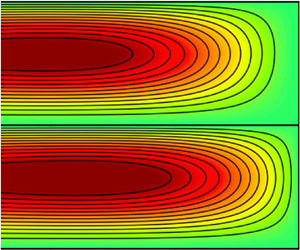No CrossRef data available.
Article contents
Bénard convection in a slowly rotating penny-shaped cylinder subject to constant heat flux boundary conditions
Published online by Cambridge University Press: 02 November 2022
Abstract

We consider axisymmetric Boussinesq convection in a shallow cylinder of radius  $L$ and depth
$L$ and depth  $H (\ll L)$, which rotates with angular velocity
$H (\ll L)$, which rotates with angular velocity  $\varOmega$ about its axis of symmetry aligned to the vertical. Constant heat flux boundary conditions, top and bottom, are adopted, for which the onset of instability occurs on a long horizontal length scale provided that
$\varOmega$ about its axis of symmetry aligned to the vertical. Constant heat flux boundary conditions, top and bottom, are adopted, for which the onset of instability occurs on a long horizontal length scale provided that  $\varOmega$ is sufficiently small. We investigate the nonlinear development by well-established two-scale asymptotic expansion methods. Comparisons of the results with the direct numerical simulations (DNS) of the primitive governing equations are good at sufficiently large Prandtl number
$\varOmega$ is sufficiently small. We investigate the nonlinear development by well-established two-scale asymptotic expansion methods. Comparisons of the results with the direct numerical simulations (DNS) of the primitive governing equations are good at sufficiently large Prandtl number  $\sigma$. As
$\sigma$. As  $\sigma$ is reduced, the finite amplitude range of applicability of the asymptotics reduces in concert. Though the large meridional convective cell, predicted by the DNS, is approximated adequately by the asymptotics, the azimuthal flow fails almost catastrophically, because of significant angular momentum transport at small
$\sigma$ is reduced, the finite amplitude range of applicability of the asymptotics reduces in concert. Though the large meridional convective cell, predicted by the DNS, is approximated adequately by the asymptotics, the azimuthal flow fails almost catastrophically, because of significant angular momentum transport at small  $\sigma$, exacerbated by the cylindrical geometry. To appraise the situation, we propose hybrid methods that build on the meridional streamfunction
$\sigma$, exacerbated by the cylindrical geometry. To appraise the situation, we propose hybrid methods that build on the meridional streamfunction  $\psi$ derived from the asymptotics. With
$\psi$ derived from the asymptotics. With  $\psi$ given, we solve the now linear azimuthal equation of motion for the azimuthal velocity
$\psi$ given, we solve the now linear azimuthal equation of motion for the azimuthal velocity  $v$ by DNS. Our ‘hybrid’ methods enable us to explain features of the flow at large Rayleigh number, found previously by Oruba et al. (J. Fluid Mech., vol. 812, 2017, pp. 890–904).
$v$ by DNS. Our ‘hybrid’ methods enable us to explain features of the flow at large Rayleigh number, found previously by Oruba et al. (J. Fluid Mech., vol. 812, 2017, pp. 890–904).
- Type
- JFM Papers
- Information
- Copyright
- © The Author(s), 2022. Published by Cambridge University Press



